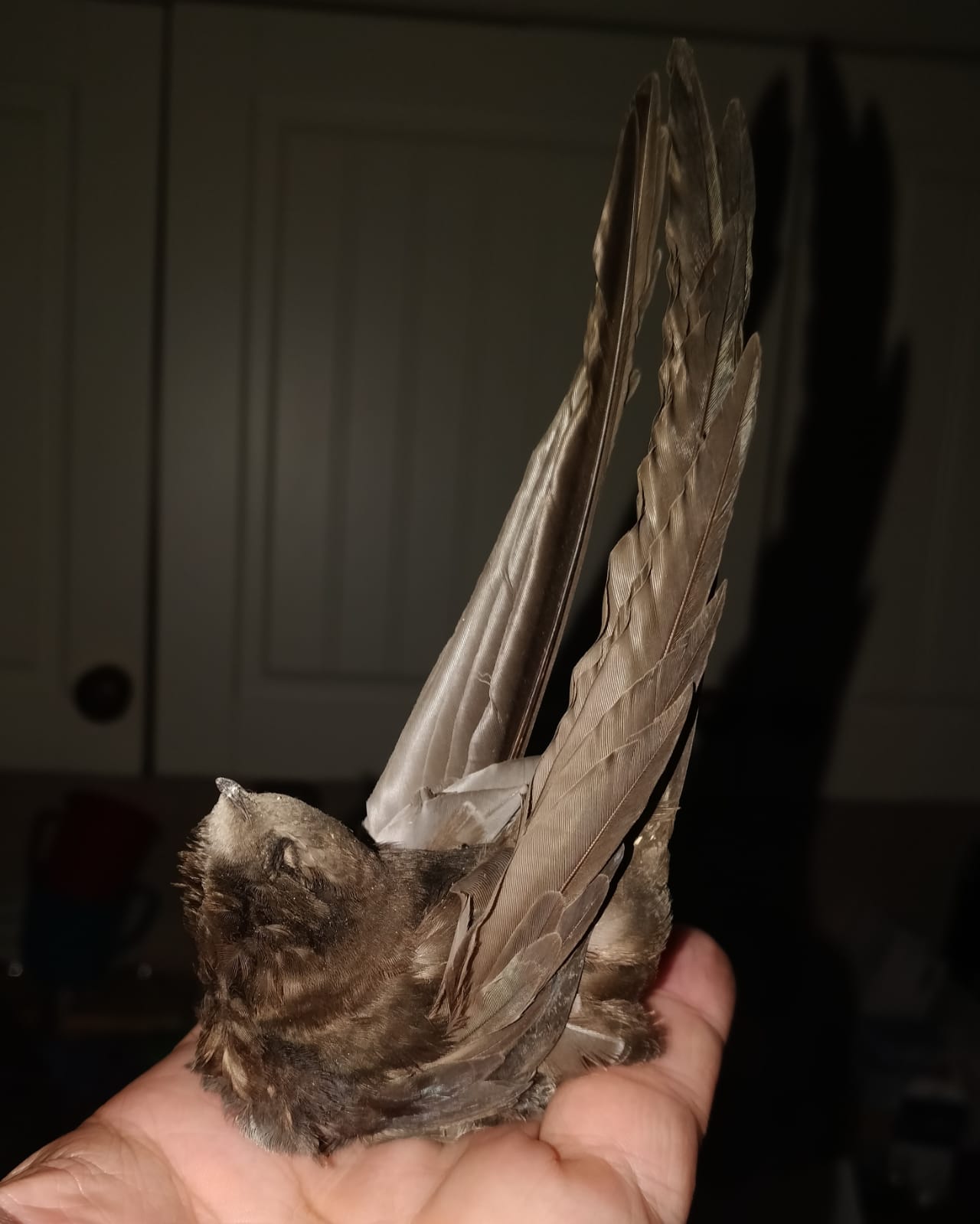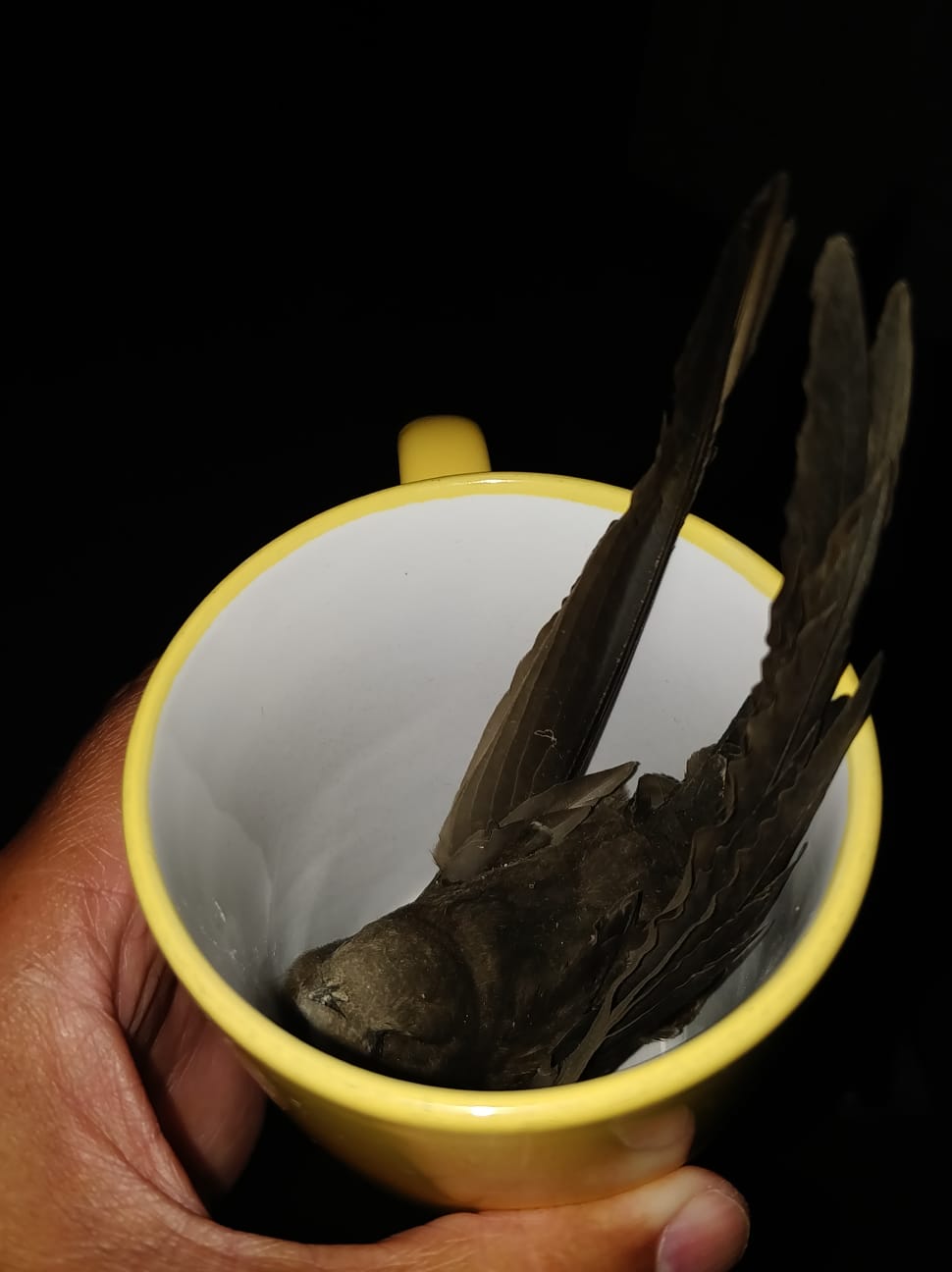WHEN the old woman died and her family began to clear out the house, they never expected to find this: a dead swift snuggled neatly into a teacup in the bedroom. it was perfectly mummified, consisting only of feathers and bone; but what happened?
Bizarre certainly, but there was more – they were to find another dead bird in the same bedroom, this time inside a wardrobe. The big Victorian red-bricked house near Antrim is exactly the sort of place that swifts would be attracted to.
If anyone would know what had happened, then Mark Smyth, swift expert beyond compare, would surely know. But even he was stumped this week.
“I knew the lady who lived there for 40 years,” mark told Dúlra, “but she had dementia for a long time before she died and then her daughter found these two birds in one of her bedrooms.
“We can only guess that the birds somehow found their way into the bedroom and flew around in a panic. One got into the wardrobe and couldn’t get out, while the other landed on the cup and couldn’t get back out.”
The bird in the cup had been dead so long that it was mummified -– made up totally of feathers, the flesh long gone. When the bird was lifted out, it remained curved. It had obviously been there for many years.
Swifts only touch land to breed, and that could be three years after they leave the nest as chicks. Touching down is riddled with danger as they’re so aerodynamic that they can’t get airborne from a standing start. One once came down in Dúlra’s garden when he was a lad and he had to fling it back into the air and it flew off unharmed.

Maybe the cup looked like somewhere relatively safe – if there is such a thing on land for a swift – but the poor bird was immediately trapped. That sort of tragic accident more often befalls bats, one local guy found 50 dead bats inside open jam jars he had stored in his attic. Again, they were able to get in but not out.
Ireland’s swifts have already left us for their journey to southern Africa, despite the island basking in the sort of weather they would love. They only spend 100 days here, from May to August, and this year Mark says that they actually left about a fortnight earlier than usual, in late July.
Mark had six breeding pairs at his home in Antrim’s Stiles estate, all attracted to purpose-built nestboxes by the sound of swift calls broadcast into the air on a recorded loop. Their average date of arrival is May 8, which means he has plenty of time to prepare for their return.
But Mark, rather than delight in the success of his nestboxes, admits he’s still fighting a losing battle. Our attitude to the swift is an indictment of our indifference to nature, despite virtue signalling the opposite.
“I’m sick of trying to convince builders and councils to put swift bricks up,” said an exasperated Mark. “They say they’re interested, but they’re not. There’s just no interest whatsoever. In England they can’t really keep up with demand, but here people just can’t be bothered.
“Even ask a church – and I’ve asked plenty – and they’ll say, no, the birds leave droppings everywhere. You tell them they don’t, but they have their own mind made up.”
Mark recently approached a head builder in a newbuild estate near his home, and again he was told that the birds will leave droppings everywhere. “He actually said that there was nothing you can say that will change my mind.
“I remember a few years ago in Tyrone when a local birder contacted me and said, ‘Come quick, the roof is about to come off the church where a colony of swifts were nesting.’
“I went down and spoke to the builders and they said there were no birds nesting the eaves. I said it was just that they hadn’t arrived from Africa yet!
“They told me to talk to the priest, but the priest he didn’t want them, he said they attract rats and mice. I told him his building dates from the 1800s and the swifts had probably been nesting there since then, and if they were going to attract rats and mice, they would have done it by now.
“But he just kept on repeating that he didn’t want the swifts nesting in his church. There was no talking to him. It was a case of all things bright and beautiful, but not in my church.” Mark says organisations like the Housing Executive don’t do enough.
“One friend in Antrim’s Newark estate has seven breeding swifts this year, it took him about five years to get to that point. But suddenly this year there was a huge influx of swifts to his colony and he went up to 16 pairs. And we worked out that the Housing Executive had been doing work nearby and blocked up all these birds’ nests, so they came to his house. This is happening across Antrim just now and you can be sure in Belfast too.”
Year after year on our watch the swift population is falling. When Dúlra was young, a pair nested on the gable of a house three doors up. Today, there doesn’t seem to be a single nesting swift in the whole estate.
Dúlra didn’t have any success this summer attracting the gabhlán gaoithe to the three boxes that Mark helped put up on his house, despite the recording of the bird’s call being blasted out from a tiny speaker. Of course, he didn’t have the boxes in place in time for the swifts’ arrival.
Mark says it’s all luck – one woman in Antrim’s Rathmore townland put up a box in May and had swifts nesting in it that night!
Next May, Dúlra will be ready for that miracle of nature when this remarkable bird returns. He’s warning the neighbours now – his swift calls will be as loud as Belsonic!
• If you’ve seen or photographed anything interesting, or have any nature questions, you can text Dúlra on 07801 414804.








